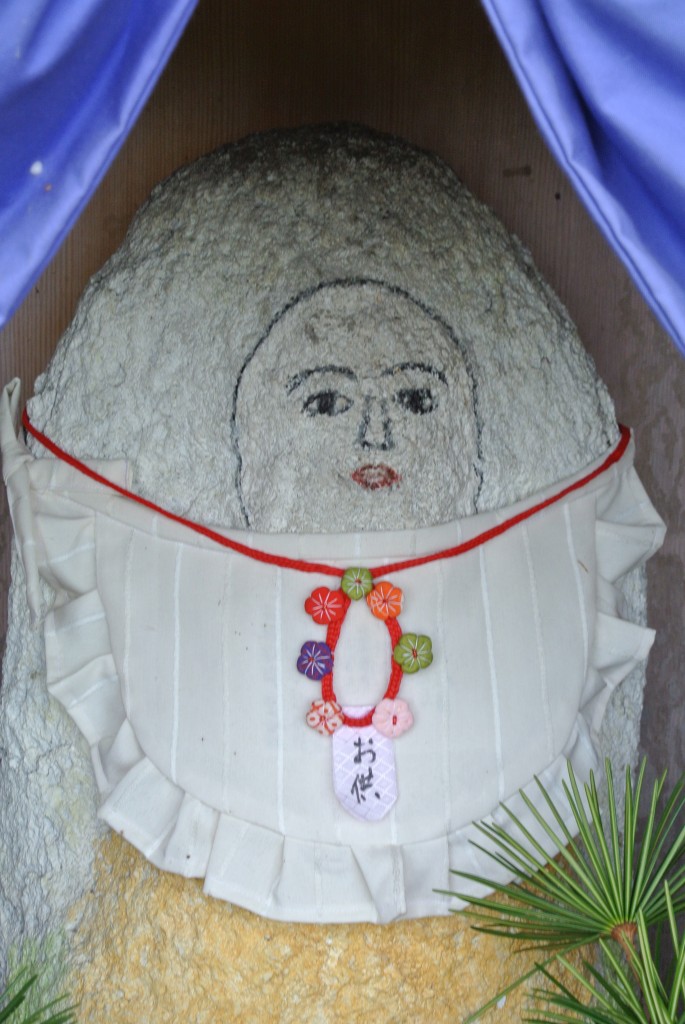
A Jizo rock in a small riverside Buddhist shrine
Walking down the Kamogawa river the other day in Kyoto, I passed a wayside Jizo shrine (see above). Nothing very unusual – you see them all over the place. Jizo has to be the most popular deity in Japan, for his statues easily outnumber all others. Not only is he a guardian of travellers, which is why he’s often found at roadsides and crossroads, but he helps guide dead souls on the tricky passage into the next world, children in particular.
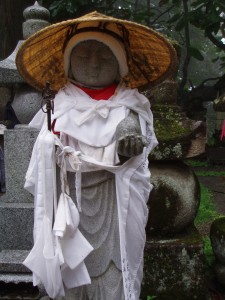
Jizo in his guise as a monk
Mark Schumacher’s excellent page about Jizo describes the deity’s Indian origins and the first recorded appearance in Japan in the Nara period. Jizo rose to prominence in the Heian period, when fears about the end of Buddhist Law (Mappo) were rife. Later in the fourteenth and fifteenth centuries, when Pure Land preachers frightened audiences with the horrifying hell awaiting lost souls, Jizo was championed as a saviour. It was around this time apparently that he became represented by the rock figures that are so numerous throughout Japan.
As a boddhisattva, Jizo is understood to have vowed to stay on in this world after death to help save fellow mortals. He’s often pictured as a simple wandering monk, with staff in hand, which made poor villagers feel an affinity for him. He was accessible, approachable and all too human. No doubt the image helped spread his cult, as did the notion that he could be represented by a mere rock rather than a sumptuous gilded statue. As such he would have fitted in with the dosojin rock figures which acted as border guardians in rural areas.
Though essentially Buddhist in origin, Jizo has been incorporated into the syncretic world of Japanese deities. He had already taken on Taoist qualities in China, and to my friends in Japan he’s ‘the kami of children’. It’s because of his role as a protector of children that he often gets a red bonnet and bib (red drives away illness, caps and bibs because of his role in saving children).
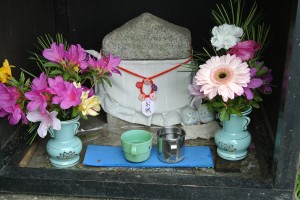
Rock, pure and plain
So here’s what I wondered as I wandered along the River Kamo. Why on earth is Jizo depicted as a rock? Usually a human face is drawn on it, but not always. Often Jizo appears as just a rock, plain and simple. Pure rock. No other Buddhist deity gets treated in this way, not surprisingly since they are considered to have been human at some stage. So to paraphrase Groucho Marx, why a rock?
There’s only one explanation that I can think of: Jizo has been absorbed into Japan’s shamanic folk heritage. In East Asian shamanism, rocks are associated with the spirits of the dead. Dust to dust runs the Christian refrain, and in death we return to the earth (which is after all a great big rock hurtling around in space). Corpses were left in ancient times on mountain sides to rot or were buried in tombs, and the spirits of the dead were thought to seep into the adjacent rock. In this way they became part of the durable, permanent, everlasting world after death. It stood in contrast to this transient life of perishable matter.
On his website Mark Schumacher points out that Jizo translates as ‘Earth Womb’. Ha-ha! Here then is the vital key to understanding the phenomenon. Jizo’s association with death and rebirth in the Pure Land means that he represents the womb-tomb to which we all return. Death is our inevitable fate, and Jizo is a rock on which we can all depend.
Rock solid. Rock hard. Rock for ever… Jizo rocks on as a syncretic, shamanic reminder of Japan’s deepest spiritual impulses.
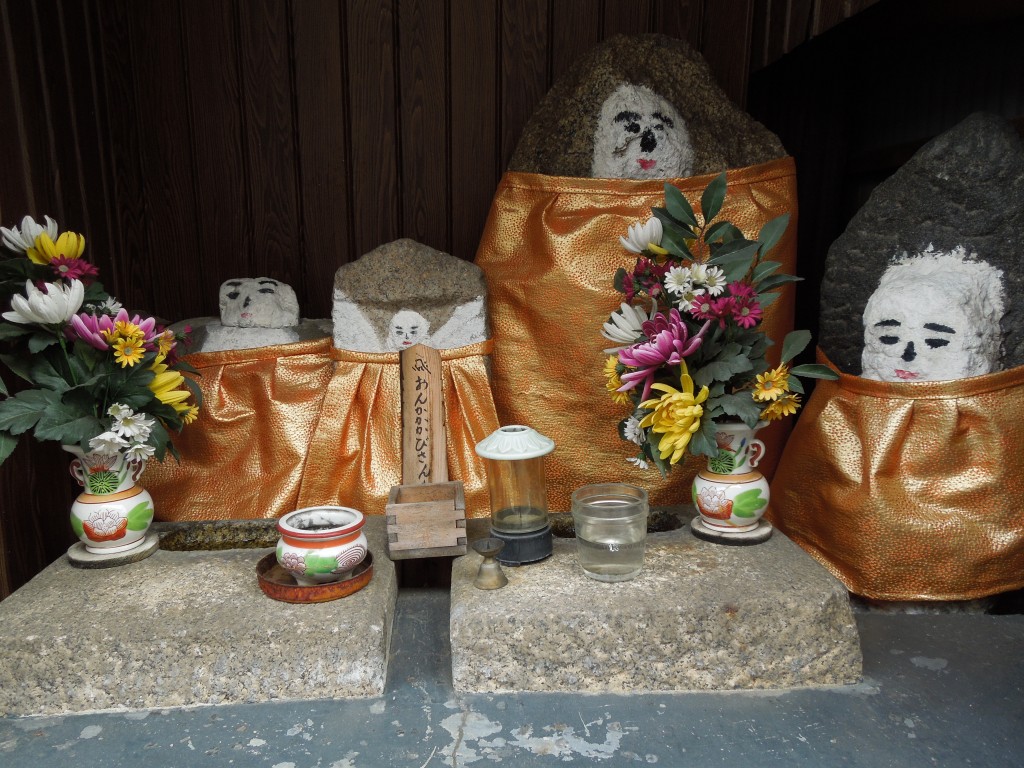
Jizo guarding the neighbourhood in which I live
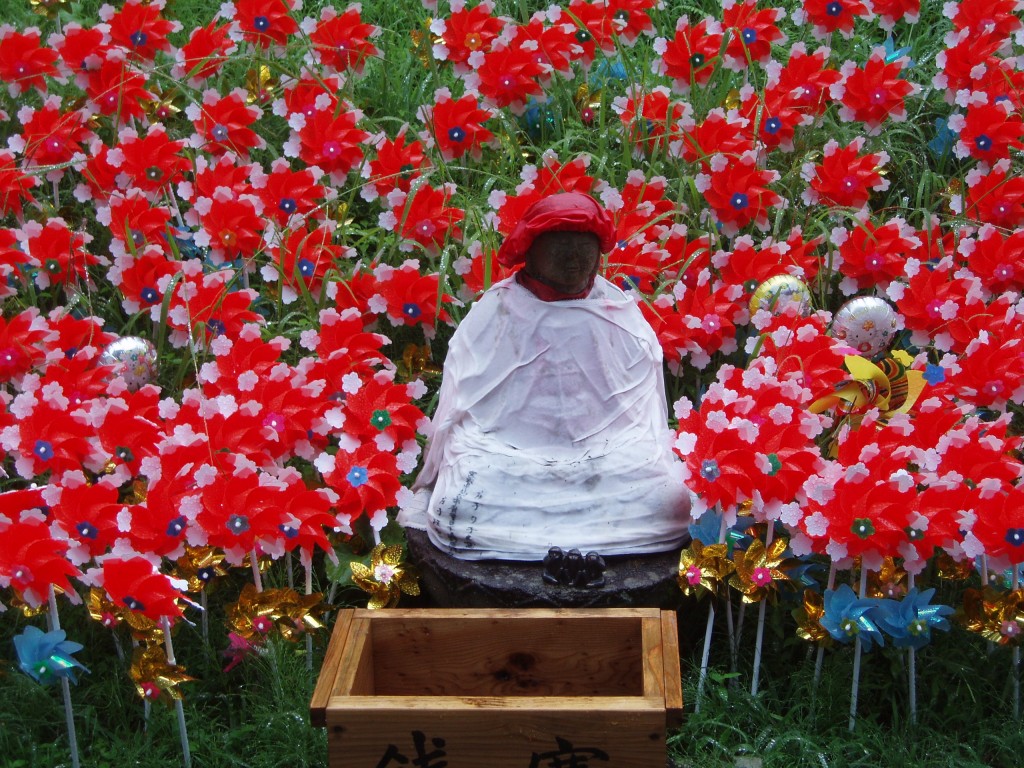
One of Jizo's roles is saving the souls of aborted and miscarried babies, hence he is often surrounded by baby goods
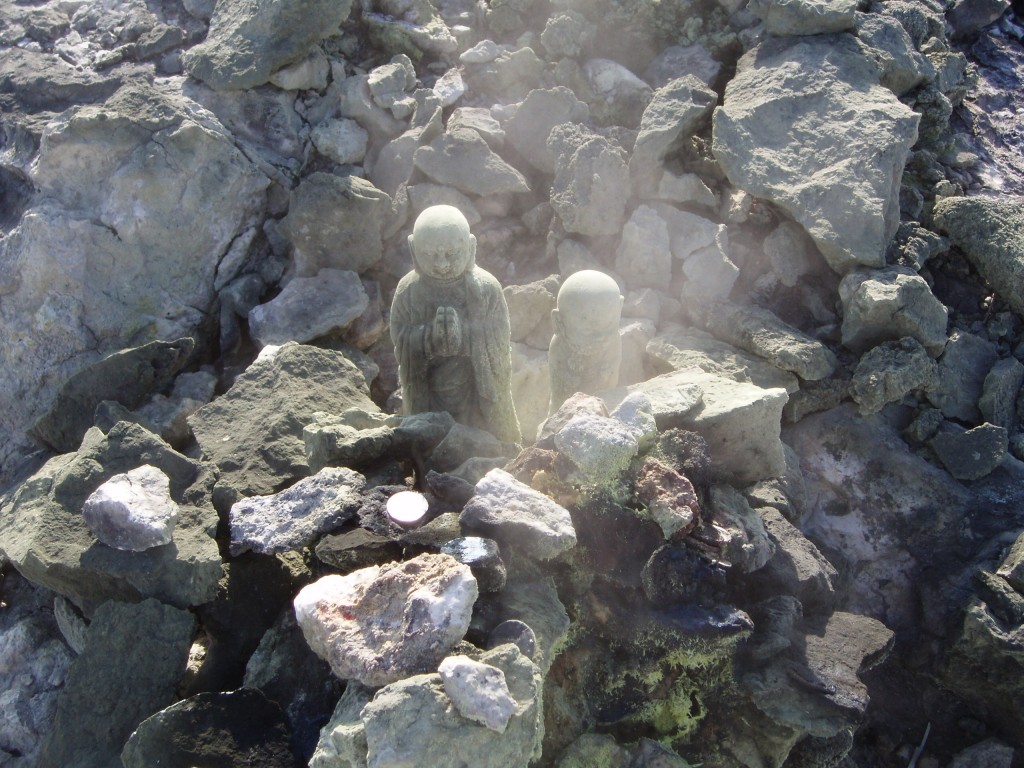
Jizo at Mt Osore, symbolically guiding the souls of the dead across the Sai no Kawara (dry river bed) that separates this world from the next
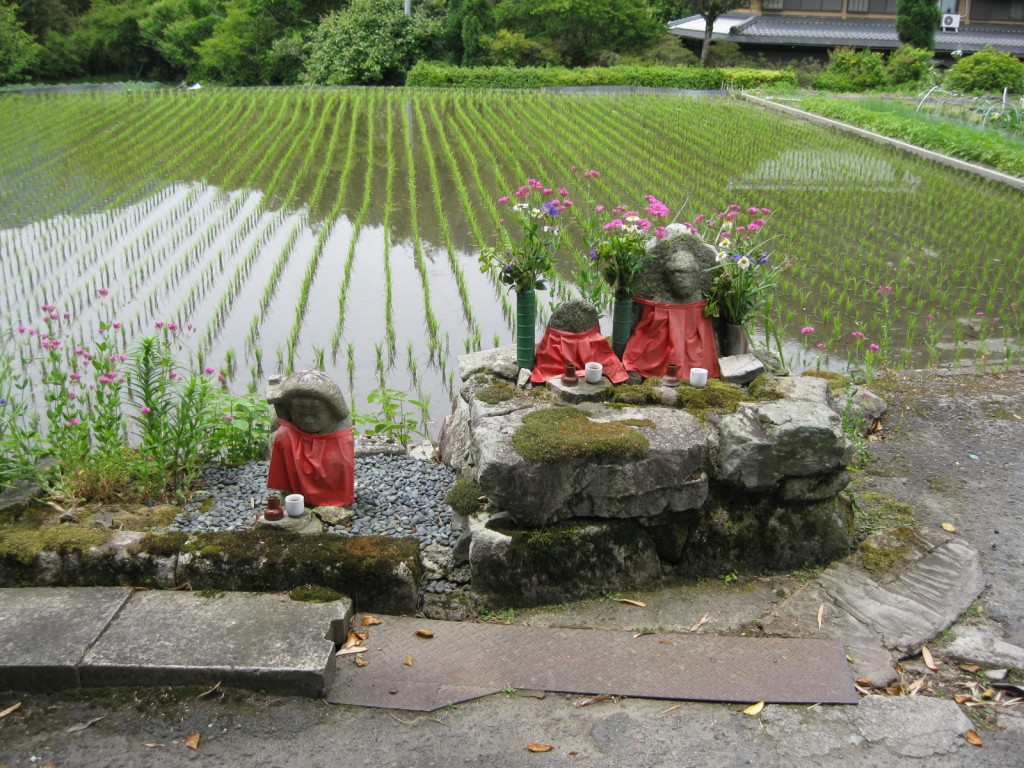
Wayside Jizo, in his guise as guardian of travellers
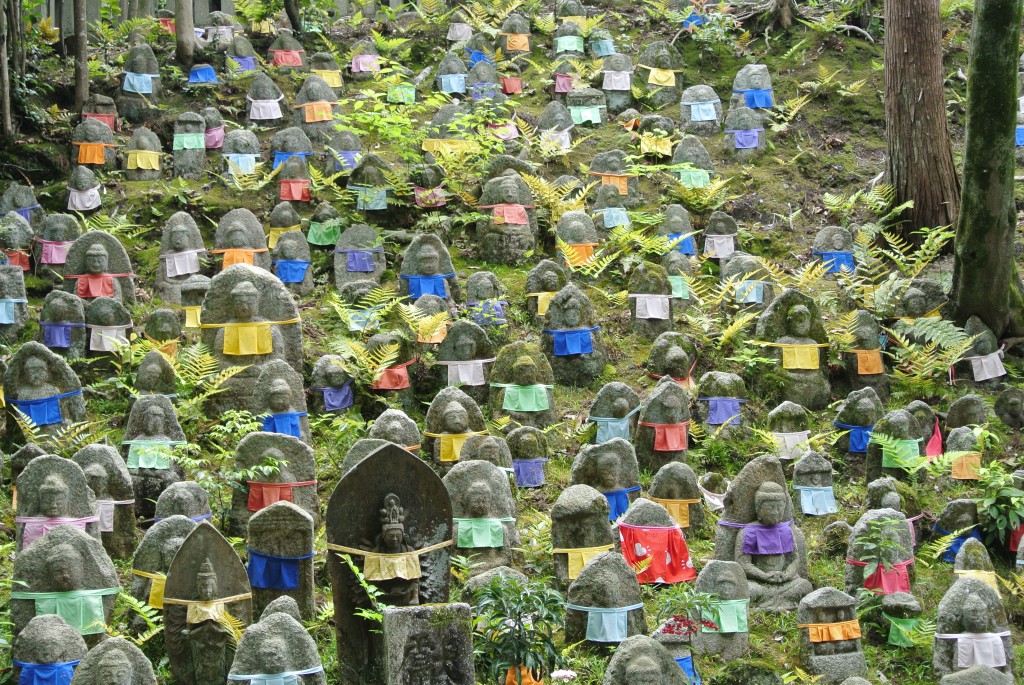
Array of Jizo at Kiyomizu temple in Kyoto

Lord Dougill. A most fascinating topic. Thank you for your enjoyable overview and for referring to my site. I’d like to comment on one point. You wrote: “To my friends in Japan Jizō is ‘the kami of children.’ It’s why he often gets a red bonnet and bib (red drives away illness, caps and bibs because of his role in saving children).”
Hmmm. There are a number of theories about the significance of the color red in Japan’s combinatory Buddha-Kami traditions (see link below), but none “directly” attribute the red caps and bibs (as you do) to Japan’s “kami” tradition. Interestingly, only a small number of deities and animal avatars are decked in red in Japan, most notably Jizō, Kannon, and Binzuru from the Buddhist camp and the fox, monkey, and shishi lion-dogs from the Kami camp. This latter group of animal kami nearly always stand guard outside the gates of Shinto shrines and are typically made of stone — so perhaps you are right to emphasize the “kami” influence on the Japanese tradition of clothing deities/animals in red. Nonetheless, we cannot ignore the same red tradition in the Buddhist camp, and thus it is very difficult to declare either the Shinto camp or Buddhist camp as the sole source of this red tradition.
Lastly, your suggestion that Jizō has been “Shintōized” — i.e., adopted as a “kami” — is most intriquing. I believe you are essentially correct. Your ideas about the womb-tomb-rock is one good example of this “Shintoization” of the Buddhist deity Jizō.
http://www.onmarkproductions.com/html/jizo1.shtml#RedBibHat
http://www.onmarkproductions.com/html/color-red.html
Hi Mark and many thanks for that….
I’m glad my hastily written and somewhat misleading sentence about the red bibs elicited such good information from you….
Perhaps in return I could take up your ‘animal kami’ reference and point out that the animals are only servants or messengers. The fox serves Inari, the monkey Sanno, and the lion-gods are guardians. If I’m not mistaken, they belong to a later form of shamanism than the Bear Spirit of the Ainu, when the animal really was the ‘kamui’ being revered. Joseph Campbell writes well about the guilty need of ancient humans to propitiate the spirit of the animal they killed, but in the case of the kami it seems to me the animals equate more to the power guides of shamans when travelling to other worlds … though the kami of Kasuga Taisha supposedly travelled physically rather than imaginatively all the way from Kashima to Kasuga on the back of a deer.
Couple of other thoughts……..I’m not exactly sure when Jizō was enlisted as a Dōsojin, nor am I exactly sure when Dōsojin were first introduced in Japan, but I’d bet it was long before the 14th-15th century, when Pure Land imagery linked Jizō to prayer rocks for those in hell. If my assumption is correct, i.e., if Dōsojin were already being erected in Heian-era Japan, Jizō may have been enlisted as a Dōsojin stone marker as early as the 11th-12th century, when his cult began to spread.
As for the Shintoization of Jizō, let us recall that Jizō’s earliest association is with Prthvi (Prithvi), a Hindu goddess who personifies the earth and is associated with fertility. In the VEDAS, she is celebrated as the mother of all creatures and the consort of the sky. This early link between Jizō and fertility may also help explain why Jizō was enlisted as a Dōsojin. These stone markers ward off evil, protect travelers, and often symbolize fertility.
Hi Mark again…
According to the book ‘Gods of Myth and Stone’, the earliest recorded reference to the Dosojin is in the Heian period, so your theory may well be true.
The point about the Hindu origins is well made and ties Jizo in with animistic roots, which makes sense in terms of being represented by a rock. Many thanks for bringing that up and making the connection…
It is interesting.
I never pay attention that way but yeah
I remember these O JIZO SAN almost everywhere
in neighborhood in rice field.
In Shinto we always give life to all possible things.
this could be Shinto part of Japanese collaborating
with Shinto w/o knowing it.
Really interesting.
Hi John,
This topic has been very important to me for a number of years. I’ve long thought that Jizo are placed on the spot where a traveler has died. Though I’ve never found a single written source to verify this, it is quite obvious from my walks along the old roads. In the mountains, Jizo are nearly always somewhere along a very steep slope or atop a pass. They are often seen in clusters just outside villages (or in the case of the Nakasendo, post towns) or in grouped in front of temples. I believe that the latter are related to Shinto impurity ideas regarding death, where the spirit of a stranger is respectfully looked after, but away from the populated areas that might otherwise become “polluted.”
One of the saddest sights I’ve seen are the dozens of Jizo lining the path on that last couple of km leading to Shikoku’s Temple #88. So close, so close…
Thank you for these precious images… Hope you will visit mine, too.
With Gassho,
vj, Jizo & Chibi
David Mason, expert on Korean Sanshin, has written in to say…
“Koreans have always venerated & supplicated the spirits of outstanding boulders, cliffs & peaks, regarding them as spirits slowly manifesting into this world. Sometimes they help the process along by carving a Buddha etc into them. I have frequently seen medium/large stones set-up in shaman shrines as abodes of various spirits. Often they are decorrated with colorful ribbons or cloth, but it is rare that they have human clothing or have a face painted/drawn on them… Usually they leave the stone natural.”
Lord Dougill-sama. Jizo statues, grave markers, pagodas, rocks, stones, etc. — why are they given red bibs? Scholar Hank Glassman devotes two chapters to this topic is his wonderful new book “The Face of Jizo” — a must read !!!!!!!!!!!!!!! You will find many answers — or extremely plausible “pointers” — regarding Jizo’s association with rocks and boundary stones. See below link. I heartily recommend this book.
http://www.uhpress.hawaii.edu/p-7536-9780824835811.aspx
mark in kamakura